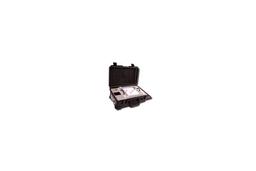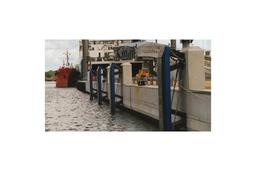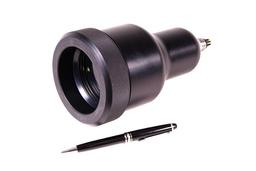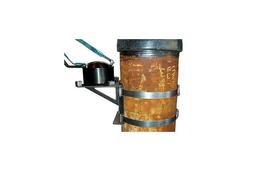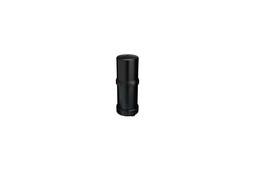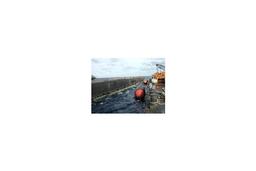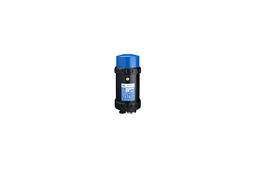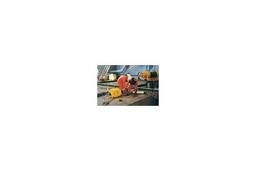


In floating production scenarios, dynamic risers and rigid steel export risers, cables and umbilicals are often required to be held subsea in a geometric configuration known as a stable catenary from vessel or platform to the riser base or export tanker, to achieve this shape a distributed buoyant load must be applied to the relevant riser section. This buoyant load can be applied using Distributed Buoyancy Modules (DBM).
It is critical that during the design life the buoyant load does not migrate or its buoyant force degrade.
We are the world's supplier of choice for Distributed Buoyancy Modules for dynamic risers. Over 90% of offshore floating production systems make use of our Distributed Buoyancy Modules.
Component Description
Our Distributed Buoyancy Modules comprise of an internal clamp and a buoyancy element together with a tensioning assembly and fastening system. They are installed using an efficient, fast and safe offshore installation procedure.
Internal Clamp
This is bolted directly onto the riser to securely lock the buoyancy module axially onto the riser. Each clamp assembly consists of the following components and incorporates several key patented features. It is without doubt the most effective means developed to date of securing buoyancy modules to flexible pipes.
Clamp Body
Cast from a tough and rigid epoxy resin composite, the buoyant clamp body has a cylindrical geometry and is split into individual segments to allow installation around the riser. This segmented configuration allows the clamp to fit a range of pipe diameters within a specified manufacturing tolerance. The bore of the clamp can be engineered with a smooth or profiled surface to suit the particular pipe structure it is being clamped to. The clamp body is also used to locate the circumferential strap.
Circumferential Strap
In order to generate the clamping pressure required to ensure the clamp/buoyancy module does not slip when subjected to external loadings (e.g. wave slam), a tensioned titanium circumferential flat strap is applied around the circumference of the segmented clamp body. The design of the strap is:
ㆍCapable of withstanding high tensile loads
ㆍCapable of storing elastic energy to cope with pipe contraction
ㆍStrong enough to withstand increases in tension due to pipe expansion
ㆍCorrosion resistant in seawater
ㆍLightweight
Tensioning Assembly
The titanium circumferential strap is tensioned using a patented titanium cross bar and screw arrangement. Rotation of the screw with a defined torque causes it to rotate, pulling the cross bars together and hence generating the required tension. Locknuts are then tightened against the cross bars to prevent loosening during the design life. Alternatively the strap can be pretensioned using a hydraulic tensioning system and held in place using tension bars and lock nuts.
Buoyancy Element
The buoyancy element, which generates an upthrust to the flexible riser, is normally supplied in two identical halves comprising of a syntactic foam core with a polymer external skin which fits around the internal clamp securely fastened together by a system of Kevlar straps and super duplex tensioners.
Syntactic foam core - each half of the buoyancy element has a composite syntactic foam core, the properties of which can be adjusted to suit the full range of seawater depths from 100msw to 6,000msw and beyond
Polymer external skin - the syntactic foam core is fully encapsulated within a high performance polymer external skin to:
ㆍProvide a continuous and aesthetically pleasing, highly visible surface
ㆍProtect the foam core from abrasion, external impact and marine growth
ㆍProvide the required external profile
The buoyancy element is of a cylindrical configuration split axially. The internal bore is provided with a recess which accommodates the internal clamp. The bore also flares towards the module edges which ensures that contact between riser and element does not occur even when the riser is at the minimum operating bend radius.
A set of holes through the external skin and foam core in the axial direction provide useful handling points, and the external diameter of the module is fitted with a set of circumferential grooves and recesses which accept the fastening system.
Fastening System
When fitted around the riser and internal clamp the buoyancy element halves require to be secured together. This is achieved by fitting two sets of securing straps and tensioning assemblies.
Each securing strap consists of a flat band (usually Kevlar), tensioned by a conventional titanium cross bar and screw arrangement with the fibres (not twisted or braided) parallel and longitudinal to the applied tension. The straps fit into grooves in the element's external diameter so that the assembly profile does not project beyond the external skin of the buoyancy element at any point.
After tensioning the toggle assembly is secured by means of a locknut to prevent loosening during the design life.
Materials & Testing
Clamp Body
The clamp body is cast from an epoxy resin composite providing a tough, rigid component which is also advantageously buoyant.
Circumferential Strap & Tensioning System
The strap and tensioning assembly are supplied in titanium. Titanium is highly suited to this application as it is highly corrosion resistant, making it suitable for an extended subsea service life while exhibiting highly elastic porperties for a metal. The elasticity allows for a significant amount of extension provided by the strap during tensioning. The subsequent change in riser diameter will not generate large variations in the clamp surface contact pressure.
Our clamp has no loose parts and is hinged to enable a rapid installation directly onto the riser. It is usually pre-lubricated behind the titanium band to reduce any potential loss of tension due to the capstan effect.
The requirement to prevent unscrewing of the fastenings after installation is satisfied by the use of two locknuts which prevent the socket head cap screws from rotating following tensioning.
The multi-jaw configuration ensures that "as manufactured" tolerances are readily accommodated.
The Internal Clamps supplied by us are subjected to a comprehensive test programme which can be tailored to suit a client's specific requirements which typically include:
ㆍBuoyancy checks
ㆍWeight checks
ㆍClamp strap capacity checks
ㆍCoefficient of friction checks
Buoyancy Element
Foam Core
The foam core is manufactured from a composite syntactic foam with three main constituents:
ㆍBase polymer
ㆍGlass microspheres
ㆍMacrospheres
The resulting material has a nominal density which varies according to the specific water depth of the application. An additional allowance is made to the Final Module Buoyancy to cover losses during the design life. An allowance for marine growth may also be added to the Final Buoyancy Module. This new value is known as the Initial Module Buoyancy.
External Skin
The external skin can be moulded or sprayed in a suitable high performance polymer. This is a tough, inert, impact resistant material which is suitable for an extended marine service. The colour of the skin is yellow as standard.
The polymer skin although non-toxic is marine growth resistant. The material is neutrally buoyant with a density of approximately 1000kg/m3적용분야

